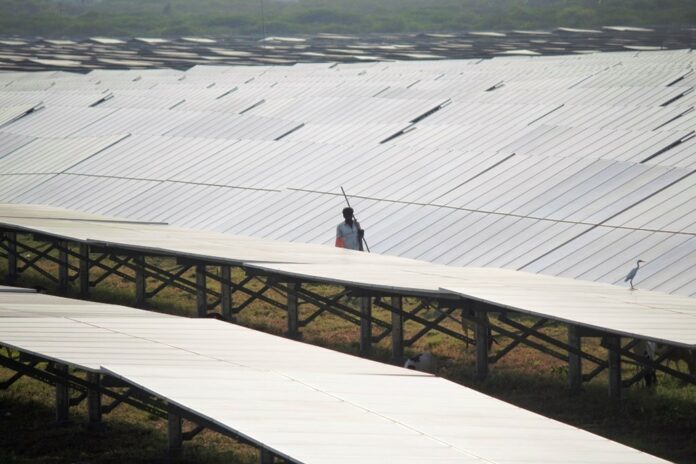Back in 2015, Muthyallappa Venkatesh and his fellow villagers from Karnataka’s Vollur village received a lucrative offer. They could earn Rs 21,000 per acre every year in exchange for covering their land with solar panels.
For a long time, Venkatesh had yearned for some kind of relief, working as an agricultural labourer in rich farmers’ lands for much of his life. His three-acre farm barely produced enough to feed his 17-member family amid prolonged spells of drought in the region.
A solar park in the village meant two things for him: Jobs and justice. “We saw what those salaries had done for our upper-caste Gowda neighbours,” says 49-year-old Venkatesh, who belongs to Adi Karnataka, a scheduled caste community. “This made us realize the importance of a steady job with a stable income for us to get out of this poverty.” Seven years on, the park has delivered little.
Venkatesh’s is among the nearly 2,000 families from five revenue villages of Pavagada taluk (administrative unit) that gave their land to the state government to set up the 2,000 megawatt solar park. Then deemed India’s biggest and among the world’s largest, it was spread across 13,000 acres of farmland. In exchange, the villagers were promised an annual rent and opportunities like jobs and local infrastructure. While the rent has come in regularly, many who once relied on agriculture have lost their source of livelihood to swathes of solar panels. Villagers we spoke with say that about 12,000 people now remain unemployed in Pavagada, and only around 2,000 could secure jobs in the park, which is further skewed by caste and gender.
To its credit, India currently boasts a solar capacity of 64.38 gigawatts. Setting up large-scale solar parks has emerged as a key pursuit for the Indian government. But the industry has also been hyped for its economic potential and as a significant source of job creation.
However, the Pavagada solar park is a telling example of how India’s solar energy sector seems to have fallen short on a key promise. The solar sector employed 85,900 workers in the 2020-21 fiscal, but a closer look paints a different picture. “The [solar] sector is likely to be an employment-intensive sector, but the quality of jobs in here could be worse and mainly related to construction or informal jobs,” says Shouvik Chakraborty, an assistant research professor at the Political Economy Research Institute at the University of Massachusetts.
Where are the jobs?
Between 2016 and 2019, as KSPDCL converted swathes of agricultural land into concrete spaces, the Pavagada villages saw the return of locals who had migrated elsewhere and now hoped to get jobs in the solar economy closer to home.
“They assured us 8,000 jobs in the park, which is less than one job per acre,” says Konappa, an MBA graduate in his 30s who hails from Thirumani village and had left his banking job in Bengaluru when the park project was announced.
Initially, says Konappa, the locals were given odd jobs at construction sites to lure others to give up their land and find work at the park.Young graduates in Pavagada are still keen on finding work at the park. Chandra Babu Naidu, a 32-year-old business management graduate, says most people are opting for industrial training diplomas as it is valued in the local job market. However, hiring at KSPDCL is competitive and those with industrial training do not qualify for most of the technical jobs, says an employee, requesting anonymity. “They prefer applicants with engineering degrees.”
“We are just a facilitator who collects lease charges from private entrepreneurs and distributes it to the landowners.,” says N Amarnath, General Manager at KSPDCL.
“We know most of the park work and the substation operation is unmanned, but we want to generate work, which is why we still hire people,” says Mahesh R., an assistant executive engineer at KSPDCL. However, an assistant engineer, on condition of anonymity, says plans are made to ensure that the blocks at the solar park require minimal human interaction.
Not everyone is complaining though. For Ashok Naidu, a 29-year-old high-school graduate, his limited education hasn’t got in the way of making money. Soon after the construction of the park was announced, he bought lorries and excavators. A member of the affluent Naidu community, he currently works as a contractor, cashing in on the “green” opportunity.
The new green economy developing within India’s labour market is plagued by the same systemic inequalities, says Chakraborty from the University of Massachusetts. “There has been little to no effort to address this.”
Reinforcing inequality
“We didn’t know how one earns a livelihood in a solar economy or what kind of agreements to consent to,” says Venkatesh, admitting that he and the others under-negotiated the worth of their lands but it was too late until they realized what had happened. “[KSPDCL] had already made away with our lands,” he says. In 2017, tenders were issued for solar developers. The Adani group, the Tata group and Finnish power company Fortum were among the developers that bagged the contracts.
Akalappa, 50, is a farmer from Thirumani who was present at some of the meetings between KSPDCL officials and the farmers in early 2016. “During the first meeting, in the presence of D.K. Shivakumar, I had mentioned that the annual lease rent would not be sufficient for the farmers,” he recalls. But KSPDCL officials, he says, refuted this claim and asked him to prove that he was making more profits on his agricultural land than the agreed rent. “We did not have any proof,” he says.
The outcomes have been worse for people belonging to disadvantaged castes, like Venkatesh. “If a rich landowner has leased land for the park, they demand that they be employed first,” he says. The 150 households that inhabit his neighborhood—mostly the SC community—have given a total of 30 acres of land to the park; one dominant-caste family would generally lease an area this size.
The skilled and high-income jobs, says Chakraborty, would continue to be dominated by dominant castes in the “new” economy.
One such job is that of contractors. Venkatesh says it is not uncommon for large landowning farmers to be contracted by KSPDCL to arrange for labourers who would work as grass cutters and panel cleaners on their land parcels.
The lack of regular salaries has also resulted in a vicious cycle of debt for villagers from the marginalized communities. Since they have to wait for the lease rent to be deposited annually, they take short-term loans from local landlords.
A bleak future
While people like Konappa, who belong to the dominant Vokkaliga community, have refused to take on low-skill jobs, those from the marginalized sections cannot afford to do so. Economists have assessed how the dominant caste members “avoid working in occupations other than that of their own, and would face unemployment voluntarily”.
“The kind of menial jobs that we used to do in the fields, our people do the same in the parks now as grass cutters and panel cleaners,” says Venkatesh.
“We don’t want our children to follow in our footsteps, but if these conditions persist, they will have no other option,” he says, looking on as the sun sets against the solar panels. “We were born in poverty; we will die in it as well.”
written by independent journalists Pragathi Ravi and Flavia Lopes
This story was supported by the Pulitzer Center.

































